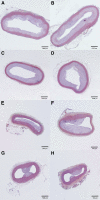The relative atherogenicity of VLDL and LDL is dependent on the topographic site
- PMID: 20086185
- PMCID: PMC3035511
- DOI: 10.1194/jlr.M003509
The relative atherogenicity of VLDL and LDL is dependent on the topographic site
Abstract
To evaluate whether the relative atherogenicity of VLDL and LDL is dependent on the topographic site, atherosclerosis was compared at four topographic sites in homozygous LDL receptor (LDLr)-deficient rabbits fed normal chow and in heterozygous LDLr-deficient rabbits with the same genetic background fed a 0.15% cholesterol diet to match cholesterol levels. VLDL cholesterol was significantly higher and LDL cholesterol significantly lower in LDLr(+/-) diet rabbits compared with LDLr(-/-) rabbits. Intimal area in the ascending thoracic aorta and in the abdominal aorta at the level of the renal arteries was 1.4-fold (P < 0.05) and 1.5-fold (P < 0.05) higher, respectively, in LDLr(-/-) rabbits than in LDLr(+/-) diet rabbits, whereas no significant difference occurred in the descending thoracic aorta and in the abdominal aorta just above the bifurcation. Differences remained statistically significant after adjustment for plasma cholesterol, triglycerides, and sex. Compared with LDLr(+/-) diet rabbits, higher intimal lipoprotein lipase (LPL) and apolipoprotein (apo) B levels were observed in LDLr(-/-) rabbits only at the level of the descending thoracic aorta. Intimal apo E levels in LDLr(-/-) rabbits were significantly lower in sites with a larger intima than in LDLr(+/-) diet rabbits. In conclusion, the relative atherogenicity of VLDL and LDL is dependent on the topographic site.
Figures

References
-
- Hutter C. M., Austin M. A., Humphries S. E. 2004. Familial hypercholesterolemia, peripheral arterial disease, and stroke: a HuGE minireview. Am. J. Epidemiol. 160: 430–435. - PubMed
-
- Twickler T., Dallinga-Thie G. M., Chapman M. J., Cohn J. S. 2005. Remnant lipoproteins and atherosclerosis. Curr. Atheroscler. Rep. 7: 140–147. - PubMed
-
- Proctor S. D., Vine D. F., Mamo J. C. 2002. Arterial retention of apolipoprotein B(48)- and B(100)-containing lipoproteins in atherogenesis. Curr. Opin. Lipidol. 13: 461–470. - PubMed
-
- Tabas I., Williams K. J., Boren J. 2007. Subendothelial lipoprotein retention as the initiating process in atherosclerosis: update and therapeutic implications. Circulation. 116: 1832–1844. - PubMed
Publication types
MeSH terms
Substances
LinkOut - more resources
Full Text Sources
Medical

